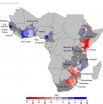(Press-News.org) July 21, 2014 (Toronto) – As part of a multinational, collaborative effort, researchers from Canada's Centre for Addiction and Mental Health (CAMH) have helped identify over 100 locations in the human genome associated with the risk of developing schizophrenia, in what is the largest genomic study published on any psychiatric disorder to date. The findings, published online in Nature, point to biological mechanisms and pathways that may underlie schizophrenia, and could lead to new approaches to treating the disorder, which has seen little innovation in drug development in more than 60 years.
The research was led by senior author Michael O'Donovan at Cardiff University School of Medicine, and CAMH was the only Canadian site in the collaboration.
Schizophrenia, a debilitating mental illness that affects approximately one out of every 100 people worldwide, is characterized by hallucinations, delusions, and disordered thinking, and often emerges in the teens and early 20s. Its lifetime impact on individuals and society is high, both in terms of direct health-care and other costs, as well as lost productivity and unemployment, which costs an estimated $6.85 billion a year in Canada.
Medications currently on the market treat only one of the symptoms of the illness (psychosis), and there are no effective treatments for the debilitating cognitive symptoms of schizophrenia. In part, treatment options are limited because the biological mechanisms underlying schizophrenia have not been understood.
Recent research focusing on the genetic underpinnings of schizophrenia has revealed the complexity of the illness. Evidence suggests that it is caused by the combined effects of many genes, and roughly two dozen genomic regions have been found to be associated with schizophrenia. The new study confirms those earlier findings, and expands our understanding of the genetic basis of schizophrenia and its underlying biology.
In the genome-wide association study (GWAS) published in Nature, the authors looked at 36,989 genetic samples from schizophrenia patients and 113,075 healthy volunteers and found 108 specific locations in the human genome associated with risk for schizophrenia. Eighty-three of those loci had not previously been linked to the illness.
"Large collaborative efforts such as this one are needed to identify genes that influence complex disorders," said Dr. Jo Knight, Senior Scientist and Joanne Murphy Professor in Behavioural Science, who spearheaded CAMH's involvement in this project. "The result is a major advance in understanding the genetic basis of brain functioning in schizophrenia," said Dr. Knight, who is also Associate Professor of Psychiatry at the University of Toronto.
The study was conducted within CAMH's Campbell Family Mental Health Research Institute, and CAMH researchers Dr. James Kennedy and Dr. Clement Zai were also on the study team.
The study implicates genes expressed in brain tissue, particularly those related to the functioning of brain cells (neurons) and of the channels enabling chemical and electrical signaling between neurons (synapses). These include genes that are active in pathways controlling synaptic plasticity – a function essential to learning and memory – and pathways governing activity in the target cell receiving signals.
Additionally, the researchers found a smaller number of genes associated with schizophrenia that are active in the immune system. This discovery offers some support for a previously hypothesized link between schizophrenia and immunological processes. The study also found an association between the illness and the region of the genome that holds DRD2 – the gene that produces the dopamine receptor targeted by all approved medications for schizophrenia – suggesting that other loci uncovered in the study may point to additional therapeutic targets.
"The fact that we were able to detect genetic risk factors on this massive scale shows that schizophrenia can be tackled by the same approaches that have already transformed our understanding of other diseases," said senior author Dr. Michael O'Donovan, deputy director of the MRC Centre for Neuropsychiatric Genetics and Genomics at Cardiff University School of Medicine. "The wealth of new findings has the potential to kick-start the development of new treatments in schizophrenia, a process which has stalled for the last 60 years."
The study is the result of several years of work by the Schizophrenia Working Group of the Psychiatric Genomics Consortium (PGC), an international, multi-institutional collaboration founded in 2007 to conduct broad-scale analyses of genetic data for psychiatric disease. A total of 55 datasets from more than 40 different contributors, including CAMH, was needed to conduct the analysis.
The samples used in this study represent all of the genotyped datasets for schizophrenia that the consortium has amassed to date. The PGC is currently genotyping new samples to further study schizophrenia and additional psychiatric diseases, including autism and bipolar disorder.
INFORMATION:
Core funding for the Psychiatric Genomics Consortium comes from the U.S. National Institute of Mental Health (NIMH), along with numerous grants from governmental and charitable organizations, as well as philanthropic donations. The Canadian contribution was funded in part by the Canadian Institutes of Health Research grant MOP-115097.
The Centre for Addiction and Mental Health (CAMH) is Canada's largest mental health and addiction teaching hospital, as well as one of the world's leading research centres in its field. CAMH combines clinical care, research, education, policy development and health promotion to help transform the lives of people affected by mental health and addiction issues. CAMH is fully affiliated with the University of Toronto, and is a Pan American Health Organization/World Health Organization Collaborating Centre. For more information, please visit http://www.camh.ca.
Media Contact:
Kate Richards
Media Relations
Centre for Addiction and Mental Health (CAMH)
416 535 8501 x36015
kate.richards@camh.ca
International team sheds new light on biology underlying schizophrenia
Genes, pathways identified could inform new approaches to treatment
2014-07-22
ELSE PRESS RELEASES FROM THIS DATE:
LSU's Mark Batzer contributes to Nature Genetics article on marmoset genome
2014-07-21
BATON ROUGE – LSU's Mark Batzer, Boyd Professor and Dr. Mary Lou Applewhite Distinguished Professor in Department of Biological Sciences in the College of Science, contributed to an article in the scientific journal Nature Genetics, titled "The Common Marmoset Genome Provides Insight into Primate Biology and Evolution," published on July 20.
Batzer contributed analysis of "jumping genes," or mobile elements that move by a sort of "copy and paste" mechanism in the genome. The marmoset is important because it is the first "New World" monkey genome to be sequenced.
An ...
Temple study compares deep vein thrombosis therapies
2014-07-21
(Philadelphia, PA) – Patients who have a clot in their legs and are considering whether to be treated with traditional blood-thinning medication or undergo a minimally-invasive catheter-based clot removal procedure should feel comfortable that there is no difference in death rates between the two treatments, although there are more bleeding risks with the catheter procedure, according to a study by Temple University School of Medicine researchers. The study involved a review of more than 90,000 cases nationwide.
Riyaz Bashir, MD, a specialist in interventional cardiology ...
'Moral victories' might spare you from losing again
2014-07-21
It's human nature to hate losing.
Unfortunately, it's also human nature to overreact to a loss, potentially abandoning a solid strategy and thus increasing your chances of losing the next time around.
That's one conclusion of a Brigham Young University study published this week by the journal Management Science. The finding is based on an analysis of two decades of data on NBA coaching decisions.
The researchers focused on whether coaches adjusted their personnel following games where the margin of victory or defeat was small. After narrow wins, coaches changed their ...
Water, water -- not everywhere: Mapping water trends for African maize
2014-07-21
Today's food production relies heavily on irrigation, but across sub-Saharan Africa only 4 percent of cultivated land is irrigated, compared with a global average of 18 percent. Small-scale farming is the main livelihood for many people in the region, who depend on rainfall to water their crops.
To understand how climate change may affect the availability of water for agriculture, researchers at Princeton University analyzed trends in the water cycle in maize-growing areas of 21 African countries between 1979 and 2010. The team examined both levels of rainfall and the ...
Global warming 'pause' since 1998 reflects natural fluctuation
2014-07-21
Statistical analysis of average global temperatures between 1998 and 2013 shows that the slowdown in global warming during this period is consistent with natural variations in temperature, according to research by McGill University physics professor Shaun Lovejoy.
In a paper published this month in Geophysical Research Letters, Lovejoy concludes that a natural cooling fluctuation during this period largely masked the warming effects of a continued increase in man-made emissions of carbon dioxide and other greenhouse gases.
The new study applies a statistical methodology ...
Mammoth and mastodon behavior was less roam, more stay at home
2014-07-21
Their scruffy beards weren't ironic, but there are reasons mammoths and mastodons could have been the hipsters of the Ice Age.
According to research from the University of Cincinnati, the famously fuzzy relatives of elephants liked living in Greater Cincinnati long before it was trendy – at the end of the last ice age. A study led by Brooke Crowley, an assistant professor of geology and anthropology, shows the ancient proboscideans enjoyed the area so much they likely were year-round residents and not nomadic migrants as previously thought.
They even had their own ...
NIH-supported scientists demonstrate very early formation of SIV reservoir
2014-07-21
WHAT:
Scientists have generally believed that HIV and its monkey equivalent, SIV, gain a permanent foothold in the body very early after infection, making it difficult to completely eliminate the virus even after antiretroviral therapy has controlled it. Now NIH-supported researchers report that SIV can become entrenched in tissues fewer than 3 days after infection, before the virus is detectable in blood plasma (the liquid part) or blood cells.
Led by Dan H. Barouch, M.D., Ph.D., of Beth Israel Deaconess Medical Center and the Ragon Institute, in collaboration with ...
National survey from AP-NORC examines perceptions of health care provider quality
2014-07-21
Chicago, July 20, 2014—The Associated Press-NORC Center for Public Affairs Research has released the results of a major survey examining the public's opinions about what it means to be a quality health care provider in the United States. The survey, funded by the Robert Wood Johnson Foundation, sheds new light on how American adults perceive the quality of their health care and doctors, as well as the information they use and trust when making health care decisions. The survey produces new and actionable data during a crucial period of Affordable Care Act (ACA) implementation. ...
Try, try again? Study says no
2014-07-21
CAMBRIDGE, MA -- When it comes to learning languages, adults and children have different strengths. Adults excel at absorbing the vocabulary needed to navigate a grocery store or order food in a restaurant, but children have an uncanny ability to pick up on subtle nuances of language that often elude adults. Within months of living in a foreign country, a young child may speak a second language like a native speaker.
Brain structure plays an important role in this "sensitive period" for learning language, which is believed to end around adolescence. The young brain is ...
Fires and Smoke in Canada's Northern Territories
2014-07-21
Environment Canada has issued a high health risk warning for Yellowknife and surrounding area because of heavy smoke in the region due to forest fires. Currently 160 wildfires are burning across the region. There are no plans for evacuation since these fires are endangering people or property. Weather that has been hitting the area recently comes with mixed results. The rains help to dampen the fires, but the lightning tends to start others.
This year the Northern Territories have seen 855,000 hectares (over 2,100,000 acres) burned as opposed to the territories 10 ...
LAST 30 PRESS RELEASES:
Numbers in our sights affect how we perceive space
SIMJ announces global collaborative book project in commemoration of its 75th anniversary
Air pollution exposure and birth weight
Obstructive sleep apnea risk and mental health conditions among older adults
How talking slows eye movements behind the wheel
The Ceramic Society of Japan’s Oxoate Ceramics Research Association launches new international book project
Heart-brain connection: international study reveals the role of the vagus nerve in keeping the heart young
Researchers identify Rb1 as a predictive biomarker for a new therapeutic strategy in some breast cancers
Survey reveals ethical gaps slowing AI adoption in pediatric surgery
Stimulant ADHD medications work differently than thought
AI overestimates how smart people are, according to HSE economists
HSE researchers create genome-wide map of quadruplexes
Scientists boost cell "powerhouses" to burn more calories
Automatic label checking: The missing step in making reliable medical AI
Low daily alcohol intake linked to 50% heightened mouth cancer risk in India
American Meteorological Society announces Rick Spinrad as 2026 President-Elect
Biomass-based carbon capture spotlighted in newly released global climate webinar recording
Illuminating invisible nano pollutants: advanced bioimaging tracks the full journey of emerging nanoscale contaminants in living systems
How does age affect recovery from spinal cord injury?
Novel AI tool offers prognosis for patients with head and neck cancer
Fathers’ microplastic exposure tied to their children’s metabolic problems
Research validates laboratory model for studying high-grade serous ovarian cancer
SIR 2026 delivers transformative breakthroughs in minimally invasive medicine to improve patient care
Stem Cell Reports most downloaded papers of 2025 highlight the breadth and impact of stem cell research
Oxford-led study estimates NHS spends around 3% of its primary and secondary care budget on the health impacts of heat and cold in England
A researcher’s long quest leads to a smart composite breakthrough
Urban wild bees act as “microbial sensors” of city health.
New study finds where you live affects recovery after a hip fracture
Forecasting the impact of fully automated vehicle adoption on US road traffic injuries
Alcohol-related hospitalizations from 2016 to 2022
[Press-News.org] International team sheds new light on biology underlying schizophreniaGenes, pathways identified could inform new approaches to treatment


